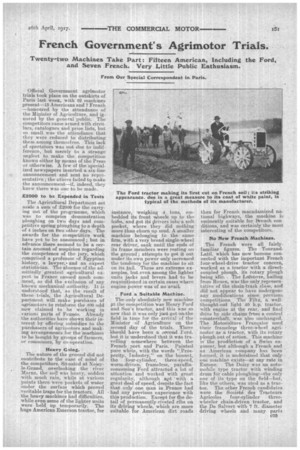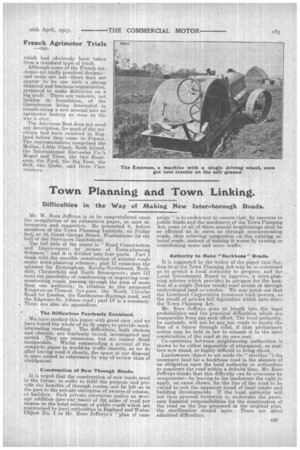French Government' s Agrimotor Trials.
Page 9

Page 11

If you've noticed an error in this article please click here to report it so we can fix it.
Twenty-two Machines Take Part: Fifteen American, Including the Ford, and Seven French. Very Little Public Enthusiasm.
From Our Special Correspondent in Paris.
Official Government agrimotor trials took place on the outskirts of Paris • last week, with 22 machines present-15 Americans and 7 French
• —honoured by the attendance of the Minister of Agriculture, and ignored by the general public. The competitors came armed with circulars, catalogues and price lists, but so small was the attendance that they were reduced to distributing them among themselves. This lack of spectators was not due to indifference, but merely to a strange neglect to make the competition known either by means of the Press or otherwise. A few of the specialized newspapers inserted a six-line announcement and sent no representative ; the others failed to make the announcement—if, indeed, they knew there was one to be made.
£2000 to be Expended in Tests
The Agricultural Department set aside a sum of £2000 for the carrying out of the programme, which was to comprise demonstration ploughing on two days and competitive spring ploughing to a depth of 4 inches on two other days. The awards for the competitive work have yet to be announced but in advance there seemed to be a certain amount of suspicion regarding the competence of the jury, which comprised a professor of Egyptian history, a lawyer,' and an .expert statistician. The absence of the admittedly greatest agricultural expert in France caused much comment, as did the exclusion of any known mechanical authority. It is understood that, as the result of these trials, the Agricultural Department will make purchases of agrimotors to reinforce the 400 odd now claimed to be working in various parts of France. Already the authorities have shown their interest by offering subsidies to the purchasers of agrimotors and making arrangements for the -machines to be bought by groups of farmers, or communes, by co-operation.
Heavy Going.
The nature of the ground did not contribute to the ease of mind of the competitors. Situated at Noisyle-Grand, overlooking the river Marne, the soit was heavy, sodden with much rain, while at various points there were pockets of water . under the surface -which proved veritable traps for the tractors. All the heavy machines had difficulties, while even some of the lighter units were held up temporarily. The huge American Emerson tractor, for instance, weighing 4 tons, embedded its front wheels up to the hubs, and got itg lrivers into a soft pocket, where they did nothing more than churn up mud. A smaller machine belonging to the same firm, with a very broad single-wheel rear driver, sank until the ends -of its frame members were resting on the ground ; attempts to get it out under its own power only increased the tendency for the machine to sit on its tail. These are extreme examples, but even among the lighter units jacks and levers had to be requisitioned in certain cases where engine power was of no avail.
Ford a Suitable Machine.
The only absolutely new machine pt the competition was Henry Ford and Son's tractor, and this was so new that it was only just .got owthe field in time for the arrival of the Minister Of Agriculture on the second day of the trials. There should have been a second Ford, but it is understood that it was travelling somewhere between the French port and Paris. Painted pure white, with the words ." Prosperity, YndUstry," on the bonnet, the four-cylinder, three-speed, worm-driven, frameless, paraffinconsuming Ford attracted a lot of attention and worke.d with great regularity, although iker with a great deal of speed, despite the fact that only one man in Prance had had any previous experience with this production. Except for the detail of permanently-riveted ribs on its driving wheels, which are more suitable for American dirt roads
than for French macadamized national highways, the machine is eminently suitable for Fthrench conditions, and was certainly the most interesting of the competitors.
No New French Machines.
The French were all fairlyfamiliar figures. The TourandLatil. which has now 'become connected with the important French four-wheel-drive tractor Concern, worked as a tractor with a directcoupled plough, its rotary plough being idle. The Lercnvre, hailing from Rouen, was the only representative of the chain-track class, and did not appear to have undergone any modifications since previous competitions. The" Filtz, well
• thought-Out light .40 h.p. tractor, with engine at the rear, and final drive by side chains from a central countershaft, was also unchanged. The Motoculture Prancaise used
• their frameless three-wheel agrimotor as a tractor, with its rotary
• plough out of action. This machine is' the prodilction of a Swiss engineer, but although a French and an American company has been formed, it is understood that only one machine' exists—at any rate in Europe. The Doisy was an automobile type tractbr with winding drum for cable ploughing—the only one of its type on the field—but, like the others, was used as a tractor. The other French candidates were the Socike des Tracteurs Agricoles four-cylinder threewheeler chain-driven tractor, and the De Salvert with 7 ft. diameter driving wheels and . many parts
which had obviously been taken from a standard type of truck. Although some of the French machines are really practical designs— and sortie are not—there does not appear to be one with a strong financial and business organization, prepared to make deliveries on a big scale. There are rumours, not lacking in foundation, . of the • Government being interested in transforming a new arsenal into an agrimotor factory as soon as the war is over.
The American fleet does not need any description, for most of the machines had been received in England before they came to France. The repres'entatives comprised the Moline, .Little Giant, Rock Island, the International Harvester Co.'s Mogul and Titan, the two -Emereons, the Ford, the Big. Four,the Bull, the Globe, and three Case tractors.
























